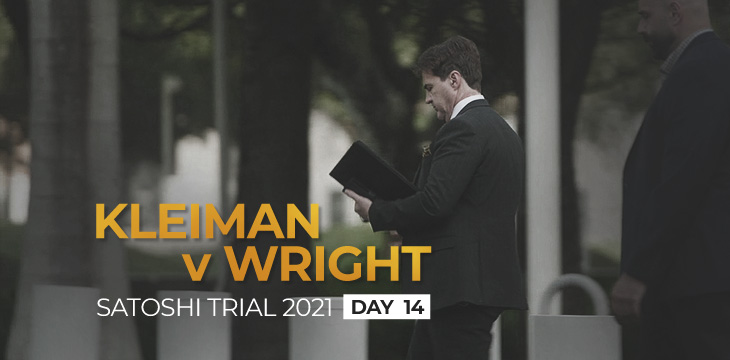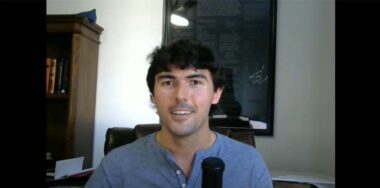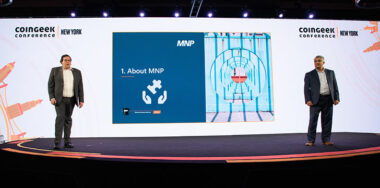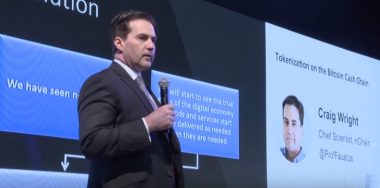Dr. Craig Wright took to the witness stand for the second time in the Kleiman v. Wright trial when the defense team called him as their final witness.
Day 14 began with plaintiff lawyer Andrew Brenner continuing his cross-examination of Dr. Ami Klin, the psychologist that specializes in Autism research. Brenner was trying to argue that Dr. Klin is a professional expert witness, that he was paid a lot of money by the defendant’s counsel, and that the methodology he used to ultimately diagnose Dr. Wright with autism was flawed.
Brenner tried to make the argument that there are 425 questions on one of the questionnaires that Dr. Klin and his team used to diagnose Dr. Wright, but that they did not ask Dr. Wright all the questions on that list.
Dr. Klin held his ground and pushed back, making it clear that psychology is a complex field that he has spent many decades working in, and that Brenner was misrepresenting and misunderstanding many of the psychologist’s documents in a way a doctor would never do.
During defense lawyer Amanda McGovern’s redirect, Dr. Klin reiterated that he stands by his diagnosis of Dr. Wright being on the spectrum.
Dr. Wright back to the witness stand
Dr. Craig Steven Wright was the next—and final—witness to be called to the stand. Defense lawyer Andres Rivero started his examination by asking Dr. Wright if he ever had a business partnership agreement with Dave Kleiman to invent and mine Bitcoin under the pseudonym Satoshi Nakamoto. Dr. Wright answered “no.”
Rivero then asked Dr. Wright many questions about his childhood, his upbringing, his education, and his career history.
One of the most meaningful pieces of evidence to come out of Dr. Wright’s examination was a document in which Dr. Wright talks about a “P2P e-cash.” Dr. Wright says he originally had an idea for a system like this in 1998, and the first iteration of it was the token system he created for Lasseters, an online casino. Dr. Wright said he tried to pitch the idea of P2P cash to BDO, and that he had a meeting with Allan Granger from BDO in which they set the delivery timeline for the project (TimeChain). However, Dr. Wright said BDO ultimately did not accept his proposal to create the P2P e-cash.
“I was proposing something that later became Bitcoin,” said Dr. Wright, before explaining that much of the code used in Lasseters token system and the idea he pitched to BDO was also used in Bitcoin.
Dr. Wright also talked about some of the individuals that were early to Bitcoin and made significant contributions, such as Hal Finney, Wei Dai, and Gavin Andresen. Dr. Wright talked about how several versions of the Bitcoin white paper were created until he felt he had something ready to be released into the world. He said the first version was roughly 60 pages, the second version was shorter, and that the third version was even more succinct. Dr. Wright says the third version was the one he shared with Dave Kleiman.
Dr. Wright also said he spent AUD600,000 on computers and about AUD11,000 monthly on electricity in Bitcoin’s early days. He also talked about how he sold a lot of Bitcoin’s intellectual property from one of his companies into another one of his companies—both of these expenses appear on Dr. Wright’s Australian Taxation Office (ATO) tax documents.
Dr. Wright concluded his testimony by saying he never stole, defrauded, or had an agreement with Dave Kleiman.
Plaintiffs cross-examine Wright
In his cross-examination, plaintiff’s lawyer Vel Freedman highlighted the areas where Dr. Wright contradicted himself.
In one instance, Dr. Wright testified that Dave Kleiman edited the 60-page version of the white paper, but right before Freedman’s cross-examination, Dr. Wright testified that Dave Kleiman was not given the white paper until its third—much shorter—version.
In another instance, Dr. Wright testified that his computer expense can be found in one of his tax documents with the ATO, but Freedman produced a piece of evidence that stated, “The ATO audit reports for these entities [Dr. Wright’s businesses] contain no reference to bitcoin…the audit records of these entities do not refer to any transactions involving bitcoin.”
In a third instance, Dr. Wright testified that he was mining Bitcoin from a few different locations in its earliest days, but Freedman produced Dr. Wright’s video deposition for the court, where Dr. Wright says he only mined Bitcoin from one location in Australia.
Freedman also made one more attempt to tie the Australia-based IP address, which sent emails to Ira Kleiman and allegedly forged emails, to Dr. Wright. The plaintiff’s lawyer showed the court that it was not just one email from Dr. Wright that had that IP address, but that several emails that Dr. Wright sent came from that IP address.
All in all, Freedman wanted the court to make the observation that Dr. Wright was untruthful and dishonest.
The defense chose not to do a redirect of Dr. Wright, and instead, rested their case.
What happens next?
In my opinion, the case was 50/50 for a long time—I had no idea who was going to win, or which legal counsel was in the lead. When the plaintiffs made their case, I thought their physical and digital evidence was very strong and had the ability to sway the court in their favor. The plaintiff’s main argument is that Dr. Wright and Dave Kleiman had a verbal agreement to mine Bitcoin together, and they are saying that a verbal agreement constitutes a partnership. Interestingly, one of the questions that lives at the core of the case is whether Dr. Wright fraudulently transferred Dave Kleiman’s assets to himself, but the plaintiffs did not spend much time arguing this point.
When it came time for the defense to make its case, I thought they did a great job of making their verbal arguments, although I did believe the presentation of their physical and digital evidence was very sloppy at times. Overall, their arguments made it clear that there is zero evidence that Dr. Wright and Dave Kleiman had a partnership in which they mined 1.1 million Bitcoin together—the defense did a good job of getting that point across…but will that be enough?
I am worried about how both sides’ arguments landed with the jury—a group in which 10% of its members were asleep at all times. More importantly, I do not know how the jury is going to interpret or understand the words “verbal agreement,” and that is really the part that worries me.
The plaintiffs are arguing that it was a verbal agreement, yet, they never described what a verbal agreement is. In my opinion, they did this purposefully, so that the definition of “Verbal Agreement” is fluid in a way that may just cause the jury to side with them, instead of the defense who showed that there is no evidence that a formal or legitimate partnership existed between Dr. Wright and Dave Kleiman.
A verdict is on the horizon, and at this point, it is unclear to me who has more points on the scoreboard. I also have no idea what the jury thinks of it all; however, that uncertainty of mine could come to an end on Tuesday. There is a good chance that the jury delivers the verdict before the end of Day 15 after the legal counsels deliver their closing arguments. We will have to wait and see what they decide.
CoinGeek features Kurt Wuckert Jr. in recap coverage which will be livestreamed daily at 6:30 p.m. EST on our YouTube Channel.
Watch our Day 14 Special Report from the Kleiman v Wright trial here:
Check out all of the CoinGeek special reports on the Kleiman v Wright YouTube playlist.
New to blockchain? Check out CoinGeek’s Blockchain for Beginners section, the ultimate resource guide to learn more about blockchain technology.









